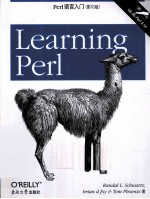图书介绍
Perl语言入门 原书第6版PDF|Epub|txt|kindle电子书版本网盘下载

- RandalL.Schwartz,TomPhoenixBrianDFoy著 著
- 出版社: 南京:东南大学出版社
- ISBN:9787564130848
- 出版时间:2011
- 标注页数:368页
- 文件大小:16MB
- 文件页数:389页
- 主题词:Perl语言-程序设计-英文
PDF下载
下载说明
Perl语言入门 原书第6版PDF格式电子书版下载
下载的文件为RAR压缩包。需要使用解压软件进行解压得到PDF格式图书。建议使用BT下载工具Free Download Manager进行下载,简称FDM(免费,没有广告,支持多平台)。本站资源全部打包为BT种子。所以需要使用专业的BT下载软件进行下载。如BitComet qBittorrent uTorrent等BT下载工具。迅雷目前由于本站不是热门资源。不推荐使用!后期资源热门了。安装了迅雷也可以迅雷进行下载!
(文件页数 要大于 标注页数,上中下等多册电子书除外)
注意:本站所有压缩包均有解压码: 点击下载压缩包解压工具
图书目录
1.Introduction1
Questions and Answers1
Is This the Right Book for You?1
Why Are There So Many Footnotes?2
What About the Exercises and Their Answers?3
What Do Those Numbers Mean at the Start of the Exercise?4
What If I'm a Perl Course Instructor?4
What Does"Perl"Stand For?4
Why Did Larry Create Perl?5
Why Didn't Larry Just Use Some Other Language?5
Is Perl Easy or Hard?6
How Did Perl Get to Be So Popular?7
What's Happening with Perl Now?7
What's Perl Really Good For?8
What Is Perl Not Good For?8
How Can I Get Perl?9
What Is CPAN?10
How Can I Get Support for Perl?10
Are There Any Other Kinds of Support?10
What If I Find a Bug in Perl?12
How Do I Make a Perl Program?12
A Simple Program13
What's Inside That Program?15
How Do I Compile My Perl Program?16
A Whirlwind Tour of Perl17
Exercises18
2.Scalar Data21
Numbers21
All Numbers Have the Same Format Internally22
Floating-Point Literals22
Integer Literals22
Nondecimal Integer Literals23
Numeric Operators23
Strings24
Single-Quoted String Literals25
Double-Quoted String Literals25
String Operators26
Automatic Conversion Between Numbers and Strings27
Perl's Built-in Warnings28
Scalar Variables29
Choosing Good Variable Names30
Scalar Assignment31
Binary Assignment Operators31
Output with print32
Interpolation of Scalar Variables into Strings32
Creating Characters by Code Point34
Operator Precedence and Associativity34
Comparison Operators36
The if Control Structure37
Boolean Values38
Getting User Input39
The chomp Operator39
The while Control Structure40
The undef Value41
The defined Function42
Exercises42
3.Lists and Arrays43
Accessing Elements of an Array44
Special Array Indices45
List Literals46
The qw Shortcut46
List Assignment48
The pop and push Operators49
The shift and unshift Operators50
The splice Operator50
Interpolating Arrays into Strings51
The foreach Control Structure53
Perl's Favorite Default:$_54
The reverse Operator54
The sort Operator54
The each Operator55
Scalar and List Context55
Using List-Producing Expressions in Scalar Context57
Using Scalar-Producing Expressions in List Context58
Forcing Scalar Context59
<STDIN>in List Context59
Exercises60
4.Subroutines63
Defining a Subroutine63
Invoking a Subroutine64
Return Values64
Arguments66
Private Variables in Subroutines68
Variable-Length Parameter Lists69
A Better&max Routine69
Empty Parameter Lists70
Notes on Lexical(my)Variables71
The use strict Pragma72
The return Operator74
Omitting the Ampersand74
Non-Scalar Return Values76
Persistent,Private Variables76
Exercises78
5.Input and Output81
Input from Standard Input81
Input from the Diamond Operator83
The Invocation Arguments85
Output to Standard Output86
Formatted Output with printf89
Arrays and printf90
Filehandles91
Opening a Filehandle93
Binmoding Filehandles95
Bad Filehandles96
Closing a Filehandle96
Fatal Errors with die97
Warning Messages with warn99
Automatically die-ing99
Using Filehandles100
Changing the Default Output Filehandle100
Reopening a Standard Filehandle101
Output with say102
Filehandles in a Scalar103
Exercises104
6.Hashes107
What Is a Hash?107
Why Use a Hash?109
Hash Element Access110
The Hash As a Whole112
Hash Assignment113
The Big Arrow114
Hash Functions115
The keys and values Functions115
The each Function116
Typical Use of a Hash118
The exists Function118
The delete Function118
Hash Element Interpolation119
The %ENV hash119
Exercises120
7.In the World of Regular Expressions121
What Are Regular Expressions?121
Using Simple Patterns122
Unicode Properties123
About Metacharacters123
Simple Quantifiers124
Grouping in Patterns125
Alternatives127
Character Classes128
Character Class Shortcuts129
Negating the Shortcuts131
Exercises131
8.Matching with Regular Expressions133
Matches with m//133
Match Modifiers134
Case-Insensitive Matching with/i134
Matching Any Character with/s134
Adding Whitespace with/x135
Combining Option Modifiers135
Choosing a Character Interpretation136
Other Options138
Anchors138
Word Anchors140
The Binding Operator=~141
Interpolating into Patterns142
The Match Variables143
The Persistence of Captures144
Noncapturing Parentheses145
Named Captures146
The Automatic Match Variables147
General Quantifiers149
Precedence150
Examples of Precedence151
And There's More152
A Pattern Test Program152
Exercises153
9.Processing Text with Regular Expressions155
Substitutions with s///155
Global Replacements with/g156
Different Delimiters157
Substitution Modifiers157
The Binding Operator157
Nondestructive Substitutions157
Case Shifting158
The split Operator159
The join Function160
m//in List Context161
More Powerful Regular Expressions161
Nongreedy Quantifiers162
Matching Multiple-Line Text164
Updating Many Files164
In-Place Editing from the Command Line166
Exercises168
10.More Control Structures169
The unless Control Structure169
The else Clause with unless170
The until Control Structure170
Expression Modifiers171
The Naked Block Control Structure172
The elsif Clause173
Autoincrement and Autodecrement174
The Value of Autoincrement175
The for Control Structure176
The Secret Connection Between foreach and for178
Loop Controls178
The last Operator179
The next Operator179
The redo Operator181
Labeled Blocks182
The Conditional Operator?:182
Logical Operators184
The Value of a Short Circuit Operator184
The defined-or Operator185
Control Structures Using Partial-Evaluation Operators186
Exercises188
11.Perl Modules189
Finding Modules189
Installing Modules190
Using Your Own Directories191
Using Simple Modules193
The File::Basename Module194
Using Only Some Functions from a Module195
The File::Spec Module196
Path::Class197
CGI.pm198
Databases and DBI199
Dates and Times200
Exercises201
12.File Tests203
File Test Operators203
Testing Several Attributes of the Same File207
Stacked File Test Operators208
The stat and lstat Functions210
The localtime Function211
Bitwise Operators212
Using Bitstrings213
Exercises214
13.Directory Operations215
Moving Around the Directory Tree215
Globbing216
An Alternate Syntax for Globbing217
Directory Handles218
Recursive Directory Listing220
Manipulating Files and Directories221
Removing Files221
Renaming Files223
Links and Files224
Making and Removing Directories229
Modifying Permissions230
Changing Ownership231
Changing Timestamps231
Exercises232
14.Strings and Sorting235
Finding a Substring with index235
Manipulating a Substring with substr236
Formatting Data with sprintf238
Using sprintf with"Money Numbers"238
Interpreting Non-Decimal Numerals240
Advanced Sorting240
Sorting a Hash by Value244
Sorting by Multiple Keys245
Exercises246
15.Smart Matching and given-when247
The Smart MaTch Operator247
Smart Match Precedence250
The given Statement251
Dumb Matching254
Using when with Many Items256
Exercises257
16.Process Management259
The system Function259
Avoiding the Shell261
The Environment Variables263
The exec Function263
Using Backquotes to Capture Output264
Using Backquotes in a List Context267
External Processes with IPC::System::Simple268
Processes as Filehandles269
Getting Down and Dirty with Fork271
Sending and Receiving Signals272
Exercises274
17.Some Advanced Perl Techniques277
Slices277
Array Slice279
Hash Slice281
Trapping Errors282
Using eval282
More Advanced Error Handling286
autodie288
Picking Items from a List with grep289
Transforming Items from a List with map290
Fancier List Utilities291
Exercises293
A.Exercise Answers295
B.Beyond the Llama331
C.A Unicode Primer343
Index353